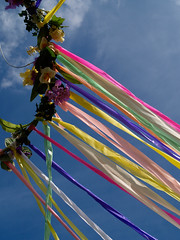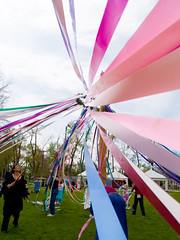 It's that time of year again, when the snows on the valley floor have melted away, when the grass is greening and the trees are blooming in preparation for the long, hot summer ahead. The quickening stir that began at the Spring Equinox has developed into the full-fledged celebratory dance of Beltane. However you spell it (and there are several variations) the most common versions of the rites of Beltane are a hodgepodge of cultures in the finest modern Pagan tradition. The word Bealtaine itself is given to us from the Irish people, who still use it as their name for the month of May. Thought by some to derive from the name of the Fire God, Bel, the traditional Celtic celebration is all about fire and it's cleansing and transformational properties, with bonfires lit and the smoke and heat used to cleanse people and cattle of impurities and illness.
It's that time of year again, when the snows on the valley floor have melted away, when the grass is greening and the trees are blooming in preparation for the long, hot summer ahead. The quickening stir that began at the Spring Equinox has developed into the full-fledged celebratory dance of Beltane. However you spell it (and there are several variations) the most common versions of the rites of Beltane are a hodgepodge of cultures in the finest modern Pagan tradition. The word Bealtaine itself is given to us from the Irish people, who still use it as their name for the month of May. Thought by some to derive from the name of the Fire God, Bel, the traditional Celtic celebration is all about fire and it's cleansing and transformational properties, with bonfires lit and the smoke and heat used to cleanse people and cattle of impurities and illness.So where does the iconic Maypole fit into all of this? The traditions surrounding the Maypole derive from celebrations associated with many Germanic countries of the northern and central European continent, and were imported to England sometime after the 1500's. The Maypole celebrations in these countries do not generally include the later English custom of entwining it with ribbons, and in the far northern latitudes, the Maypole is called the Midsummer pole and the celebrations are held at Midsummer in June instead of on or near the first of May. The modern customs surrounding the Maypole today in the US and the UK derive mainly from the 19th century revivals of May Day customs in England that were imported during the mass emigrations to the US and are kept alive in many smaller towns throughout the United States, mainly in the form of May Day celebrations in schools. Here in Utah, the town of Mendon is noted for it's elaborate May Day pageant which still takes place every year in the town square, with the election of a May Queen and her Consort.
Which brings us to the next question - What's Beltane all about? What do flowers and ribbons and a big pole have to do with Pagans? The poetic answer is that it is all about the union of the masculine and the feminine, when the God and Goddess join together to ensure the fertility of the crops, the earth and the people who celebrate them.
 The pragmatic answer is that it's all about sex. Either way, the symbolism resonates the same way, with the obviously phallic symbol penetrating a wreath and being wrapped in a sheath of ribbons... well, you get the point. But literally, when we dance the Maypole we are participating in an act of magic, whereby we energize these symbols with our own hopes and wishes, and create our own energies of fertility and abundance for our own lives. Very often, couples utilize the magic of the Maypole in order to create real fertility for themselves. I'm pleased to have a Beltane baby of our own, in our little boy. Yes it can actually be used for literal fertility! However, the energies of dancing the Maypole are also great for generating abundance in our lives, sparking creativity, and in general, suffusing our spirits with a great big dose of hope and joy. Any way you cut it, Beltane is a great day for letting your spirit run free, so come on out to SunStave Circle tomorrow, weave some flowers into your hair (men too!) and celebrate the promise of the warm summertime to come!
The pragmatic answer is that it's all about sex. Either way, the symbolism resonates the same way, with the obviously phallic symbol penetrating a wreath and being wrapped in a sheath of ribbons... well, you get the point. But literally, when we dance the Maypole we are participating in an act of magic, whereby we energize these symbols with our own hopes and wishes, and create our own energies of fertility and abundance for our own lives. Very often, couples utilize the magic of the Maypole in order to create real fertility for themselves. I'm pleased to have a Beltane baby of our own, in our little boy. Yes it can actually be used for literal fertility! However, the energies of dancing the Maypole are also great for generating abundance in our lives, sparking creativity, and in general, suffusing our spirits with a great big dose of hope and joy. Any way you cut it, Beltane is a great day for letting your spirit run free, so come on out to SunStave Circle tomorrow, weave some flowers into your hair (men too!) and celebrate the promise of the warm summertime to come!